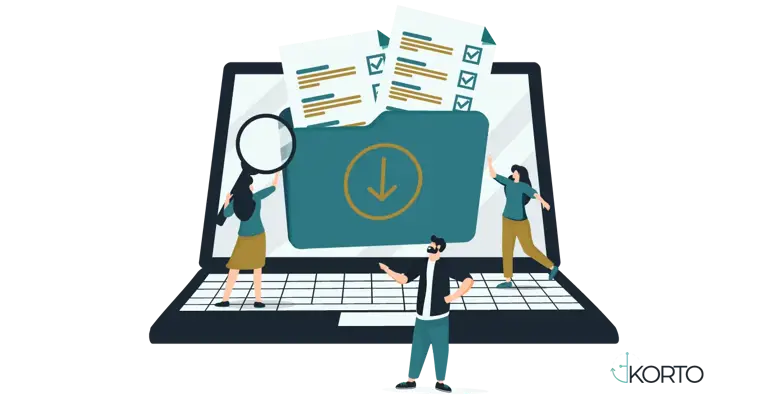What is Information in Business?

Table of Contents
To analyze, understand and explain any concept, I’ve always reverted to analogies / used conceptual thinking. I love finding similarities in complete opposite concepts and I’m excited to invite you on my storytelling journey of exploring, verifying, and disseminating records management.
The logical start would be to look at information, and if you’re anything like me, you might have thought of “data” automatically, but you’re wrong, and of course, so was I.
What are the Types of Information?
Information can be classified into several types based on its nature and use.

- Descriptive Information: Provides details and descriptions about various entities.
- Procedural Information: Outlines processes, methods, and procedures.
- Predictive Information: Used for forecasting and making predictions based on historical data.
- Directive Information: Gives instructions and guidelines.
- Analytical Information: Analyzes and interprets data to derive insights.
Understanding these types of information helps in better managing and utilizing them for various purposes. If you are looking for a software to help you out with managing information, you should take a look at KORTO.
Here’s essential content on the lifecycle of records — a must-read to help you continue your journey toward smarter records management.
Importance of Information
Information is crucial in various aspects of life and especially in business information. It drives decision-making, enhances knowledge, and facilitates communication. Let's delve deeper into its significance.
Why is Information Important in Decision-making?
Information plays a pivotal role in decision-making processes.
Here's why:
- Provides Context: Well-processed and structured information gives context to raw data, making it understandable and actionable.
- Reduces Uncertainty: Reliable information helps reduce uncertainty and risks associated with decisions.
- Improves Efficiency: Access to accurate information streamlines processes and improves operational efficiency.
- Supports Strategic Planning: It enables organizations to make informed strategic plans and long-term goals.
Information in the Digital Age
In the digital age, the nature and handling of information have evolved significantly. Digital transformation has led to:
- Increased Volume: The amount of information generated and stored digitally has grown exponentially.
- Enhanced Accessibility: Information is now more accessible through digital devices and the internet.
- Data Security: Protecting information from breaches and unauthorized access has become paramount.
- Advanced Analytics: Digital tools and technologies enable advanced data analytics, providing deeper insights and predictive capabilities.
Managing Information
Effective information management involves several practices and strategies:
- Data Collection: Gathering data from various sources.
- Data Processing: Converting raw data into a usable format.
- Storage: Ensuring data is stored securely and is easily retrievable.
- Distribution: Making information available to the right stakeholders.
- Disposal: Properly disposing of outdated or unnecessary information.
Implementing these practices ensures that information is accurate, secure, and available when needed.
Information Lifecycle
The information lifecycle outlines the stages information goes through from creation to disposal:
- Creation: Information is generated or collected.
- Storage: Information is stored for future use.
- Usage: Information is accessed and used for various purposes.
- Archival: Information that is no longer actively used is archived for long-term storage.
- Disposal: Information is securely disposed of when it is no longer needed.

Managing the information lifecycle effectively ensures data integrity and compliance with regulatory requirements.
Data vs. Information
Think of data as the raw materials, in a painting process.
Frames, canvas, oil paint, brushes, turpentine, a glass jar and rags for cleaning, a palette and easel. Using those raw materials then allow us to create paintings. Now keep in mind, the painting cannot exist without the raw materials used to create it, but those raw materials on their own, still have purpose. In the end though, the painting becomes much more valuable than the total cost of the collection of raw materials.
Now that’s exactly the relationship between data and information, with one exception to my analogy. We are talking actual completed paintings as well as photos and prints of it, videos, written descriptions, brochures, appraisals, and valuations. This means that physical as well as digital data is recognized as information.
Data processed, analyzed, placed in sequence, and or remodeled, and then structured becomes information. The most valuable benefit is that it provides context and if done right, enables decision making.
5-Second Summary
Data is the raw material; information is the masterpiece. Learn how context and structure turn raw data into decision-making gold.
FAQ
How is Information Managed throughout its Lifecycle?
Information is managed through stages of creation, storage, usage, archival, and disposal to ensure accuracy, security, and compliance. Effective management involves gathering, processing, distributing, and securely disposing of information when it's no longer needed.
How is Information Different from Data?
Data consists of raw facts and figures without context, while information is processed and structured data that provides context and meaning. In essence, information is data that has been analyzed and organized to be useful and actionable.
